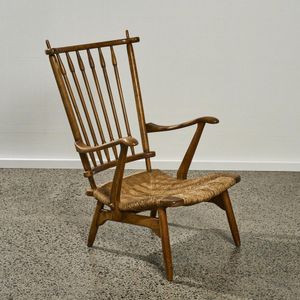De Ster Gelderland Lounge Chair
A 1950s de Ster Gelderland chair, 1950s, Netherlands. fruitwood with rush seat lounge chair by de Ster Gelderland. Height 95.8 cm, width 59 cm, depth 66 cm
You must be a subscriber, and be logged in to view price and dealer details.
Subscribe Now to view actual auction price for this item
When you subscribe, you have the option of setting the currency in which to display prices to $Au, $US, $NZ or Stg.
This item has been sold, and the description, image and price are for reference purposes only.
- Rush Seating - Associated with country style chairs, stools and settees, rush seats are woven from rushes, with the pattern of the weaving often dividing the the chair seat diagonally into four triangles.
The weaving of rushes has been practiced for centuries, and it is believed that some early rush seats of the 18th and 19th century were painted, although common practice now is to leave the rush in its natural state. As the rush ages the colour
Rushes of the type used in Europe for seating are not available in Australia, and instead fibre rush, a man-made product from one-ply twisted paper, is used. Another substitute material is twisted natural sea grass.
Seats in Danish furniture of the 1950s were often finished with Danish cord, a three ply twisted paper cord, which has a similar appearance to rush. - Fruitwood - A catch-all term used to describe the wood of any of several fruit-bearing trees, such as the apple, cherry, or pear, used especially in cabinetmaking.
With a blond colour when finished, fruitwood was used in Europe, especially France, in the 18th and 19th centuries for larger items of furniture such as tables, chairs, cabinets and bookcases but in England its use was generally restricted to decorative elements such as inlays.
This item has been included into following indexes:
